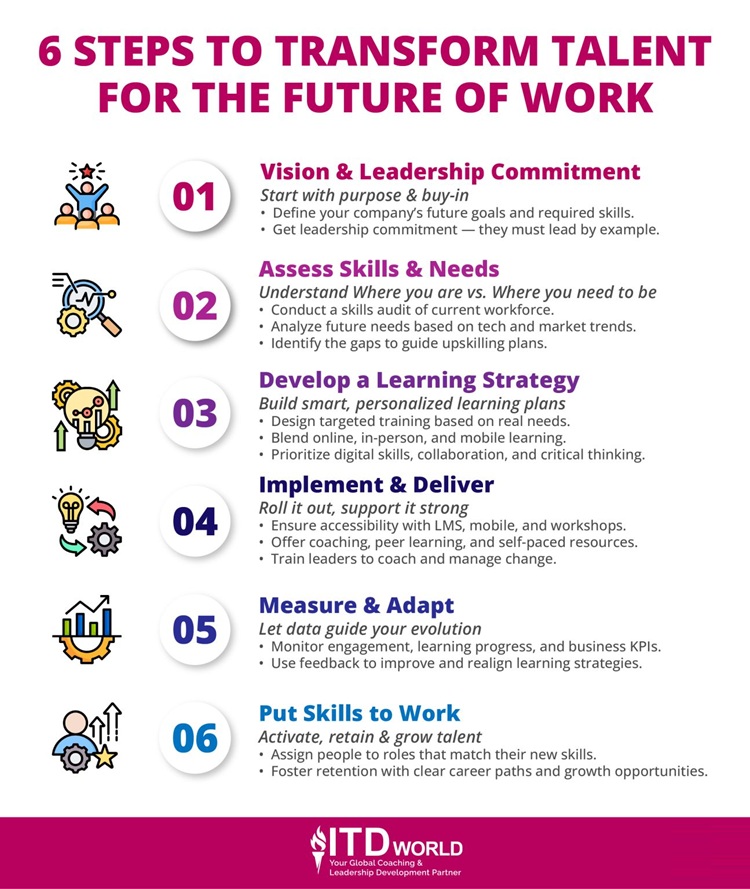In today’s rapidly changing world, building a high-performing workforce isn’t enough. Learn how talent transformation empowers your employees with the skills and agility needed to thrive in the future of work.
The landscape of work is constantly evolving, driven by technological advancements and shifting market demands. This evolution necessitates a shift in how organizations approach their talent. Simply having a skilled workforce is no longer sufficient – instead, companies must embrace talent transformation, a holistic strategy that equips employees with the skills, mindset, and adaptability to not only excel in their current roles but also navigate the uncertainties of the future.
|
Author: Jonathan M. Pham |
Highlights
- Talent transformation is about letting go of the old “disposable cog” HR philosophy and investing in upskilling and facilitating a learning culture. By equipping employees with a blend of technical and core skills like adaptability, problem-solving, and emotional intelligence, it aims to create a future-proof workforce to meet ever-changing business needs, save costs, and win the war for talent.
- The process typically follows a 6-step flow, from securing leadership buy-in and skills gap analysis to implementation, measurement, and keeping talent on board.
- Despite its benefits, talent transformation often proves challenging due to reasons such as budget constraints, resistance to change, time limitations, and measurement difficulties. That said, organizations may overcome them with solutions like blended learning, communication, microlearning, and leadership development.
- Moving forward, talent transformation is expected to place a strong emphasis on agility, personalized learning, soft skills, well-being, and data-driven talent management in a constantly evolving work landscape.
What is Talent Transformation?
Talent transformation is a process that revolves around developing the skills and potential of the existing workforce to meet the changing needs of the organization. It’s a two-pronged approach that involves:
- Upskilling employees: Equipping your staff with new knowledge and abilities so that they can adapt to new technologies, take on greater responsibilities, and contribute more effectively. This can involve training on new technologies, fostering new areas of expertise, or even helping them develop softer skills like communication or problem-solving.
- Fostering a culture of learning: Facilitating an environment where continuous learning is valued and encouraged – by providing training programs, coaching/ mentorship opportunities, or flexible work arrangements that enable people to dedicate time to professional development.
Traditional HR management often treats people like interchangeable parts, focusing on costs and control. Talent transformation, on the other hand, sees people as the company’s greatest asset, with potential waiting to be unlocked. As such, it prioritizes employee growth, well-being, and engagement, recognizing the value beyond just numbers.
| Feature | Traditional HR |
Talent Transformation
|
| Focus | Managing resources |
Developing people
|
| Employee View | Tools | Assets |
| Development | Cost control |
Employee growth & engagement
|
| Outcomes | Short-term efficiency |
Long-term potential & employee fulfillment
|
| Underlying Philosophy | People are replaceable |
People are unique with potential
|
| Priorities | Compliance, efficiency |
Well-being, development
|
Objectives of Talent Transformation
The overall goal of talent transformation is to create a more agile and adaptable workforce capable of keeping pace with the changing demands of the business world. It’s a win-win for both employers and employees: the former benefit from a more skilled and engaged workforce, while the latter feel valued and have the chance to access greater growth opportunities.
- Agility & Adaptability: With a competent and versatile workforce in place, companies are equipped to respond faster to changes in the market, technology, and customer demands.
- Innovation & Performance: Upskilled workers are more capable of bringing fresh ideas to the table and working productively, which translates to better problem-solving and higher-quality outputs.
- Bridging the skill gap: Talent transformation makes it possible for organizations to identify and address any skill deficiencies within the workforce, ensuring they have the right talent in place to achieve business goals.
- Enhance employer branding: A company that invests in its people’s growth is more attractive to top talent, making it easier to recruit and retain high performers. At the same time, it also contributes to fostering loyalty and satisfaction, reducing turnover rates and the associated costs of recruitment and onboarding.
- Prepare for the future of work: Developing a broader skillset makes employees more marketable and future-proofs their careers in a changing job market.
- Build a better workplace: The process of learning new things and mastering new competencies helps boost employee confidence and motivation, leading to a more positive and productive work environment.
By investing in their workforce, companies can build a future-ready team that is agile, innovative, and highly engaged.
The Importance of Talent Transformation in Today’s Business Landscape
The business world is constantly evolving, driven by factors like technological advancements, globalization, and shifting customer demands. To stay ahead, companies need a workforce equipped with the skills and mindset to thrive in this dynamic environment. That’s where talent transformation comes in. It’s about going beyond simply filling open positions and instead focusing on developing your existing workforce to meet the challenges and opportunities of the future:
- Shifting skillsets
The pace of technological change and economic disruption requires a workforce with adaptable skillsets. As new technologies and business models emerge, employees need to be constantly learning and upskilling to stay relevant. Given that most traditional education systems cannot satisfy the modern workplace’s learning demands, organizations need to have very specific strategies to keep team members updated on the latest knowledge/ competencies.
- The war for talent
Competition for skilled workers has never been more fierce than it is now. Today’s workers are looking for more than just a paycheck – they want opportunities to learn and develop their skills. This is especially true among younger generations like Millennials and Gen-Z. Failure to invest in upskilling means a higher likelihood of losing talent. On the other hand, by investing in the existing workforce, organizations have a higher chance of increasing employee retention and engagement, thereby reducing the need for expensive external recruitment.
- Saving costs
Training your current staff has been proven to be a more cost-effective solution than looking for and onboarding new hires (which could cost up to 1.5-2 times an employee’s annual salary). According to Pluralsight research, a whopping 97% of HR leaders said that they prioritized internal talent development over external hiring to fill skill gaps.
- Building a culture of learning
A focus on talent transformation fosters a culture of continuous learning and development – which empowers people to take ownership, innovate, and refine their problem-solving abilities.
Talent transformation is not a luxury; it is a necessity for businesses that want to survive and thrive in today’s dynamic landscape.
The Business Case for Talent Transformation
- Walmart
Walmart, a retail titan, needed to adapt to the rise of e-commerce and compete with online giants like Amazon. Their workforce, skilled in traditional retail operations, lacked expertise in areas such as data analytics and digital marketing. Hence, the company decided to launch a comprehensive talent transformation program – by partnering with online learning platforms to offer courses in data analysis, digital marketing, and cloud computing. Additionally, they created internal training programs to develop tech skills specific to their business needs.
- Salesforce
Salesforce, a leader in cloud-based CRM solutions, operates in a rapidly evolving industry. To maintain their edge, they instilled a culture of learning within the organization with an internal learning platform called “Trailhead” – where free courses on various Salesforce products and technologies are offered. On the other hand, they also encouraged employees to attend conferences, workshops, and pursue certifications.

Digital transformation is about talent, not technology
Read more: Future Ready Organization – 11 Tips to Building One Capable of Adapting to Industry Trends
The Core Skills of Talent Transformation
Talent transformation goes beyond just technical skills. To thrive in a dynamic environment, employees need to be equipped with a well-rounded skillset that includes both technical and core competencies, including:
- Adaptability & agility: The ability to learn new things quickly, embrace change, and adjust to evolving business scenarios.
- Critical thinking & problem-solving: Being able to analyze situations, identify problems, and develop creative solutions.
- Communication & collaboration: Effective communication across teams and with diverse stakeholders is essential for successful collaboration.
- Emotional intelligence (EQ): Understanding and managing one’s own emotions, as well as recognizing and responding to those of others, lays the foundation for strong relationships and teamwork.
- Self-leadership: Taking ownership of one’s learning and development, and proactively seeking out opportunities to contribute.
- Digital literacy: A basic understanding of technology and comfort using digital tools are essential for navigating the modern workplace.
- Creativity & innovation: The ability to think outside the box and generate new ideas – so as to stay ahead of the curve.
- Resilience: The ability to bounce back from setbacks and persevere through challenges.
- Growth mindset: A belief that skills and abilities can be developed through continuous learning and effort is essential for a transformed workforce.
Read more: Agility Coaching – Navigating Change & Fueling Business Success
6 Steps of the Talent Transformation Process
-
Vision & leadership commitment
A clear vision acts as a roadmap that guides talent development efforts toward the company’s strategic goals. At the same time, commitment from the management board is crucial to securing resources, fostering a culture of learning, and motivating employees to embrace transformation.
- Define the why
It all starts with a clear vision for the future. What will our business model look like in 5 years? What competitive advantage do we want? What skills and capabilities will the workforce need to visualize these strategic goals? Whatever it is, the vision statement should be concise, aspirational, and easily communicated.
Organizations may consider conducting workshops with leadership and key stakeholders to define the desired future state – while taking into account factors like industry trends, technological advancements, and competitor analysis.
Sample vision: “To become the industry leader in AI-powered solutions by building a workforce with cutting-edge data science and machine learning expertise.”
- Leadership buy-in
Executive leadership needs to be fully committed to talent transformation and champion the initiative throughout the team. For this purpose, organizations need to equip leaders with the knowledge and skills to facilitate transformation (e.g. change management, communication strategies, talent development best practices).
-
Need assessment & gap analysis
- Skills audit
The second step in talent transformation involves a thorough assessment of your current workforce’s skills and knowledge compared to the needs of future business goals. This can be done via quantitative methods such as online/offline assessments, surveys, and performance reviews – as well as qualitative ones like focus groups or interviews.
Example: Imagine an insurance company aiming to incorporate AI-powered claims processing. In this case, they can conduct a thorough evaluation of employees’ data analysis and problem-solving abilities – while also surveying their comfort levels with technology adoption.
- Future needs
Analyze your future business needs and the skills required to achieve them. Consider factors like technological advancements, market shifts, and industry trends. For example, how will emerging technologies like automation or blockchain impact your business? Are there changes in customer behavior or industry regulations that require new skill sets? What are your competitors doing? What competencies are in high demand within your industry?
Example: Continuing with the insurance company scenario, future needs analysis might reveal a growing demand for employees with data visualization skills to present complex claims data effectively.
- Identify gaps
Combine the insights from the skills audit with the future needs analysis to identify gaps. A useful technique for this step is Gap Analysis Matrix – which means creating a matrix that maps current skills against future needs and highlights areas where significant skill development is required. Based on the results, organizations may prioritize the areas where their workforce needs the most investment in terms of training, upskilling, or potential recruitment.
-
Learning & Development strategy
- Targeted programs
The next step is to translate the findings from the gap analysis into actionable training and development plans to equip the workforce with the necessary skills for the future. Offer a mix of learning delivery methods to cater to different learning styles and preferences – including online learning platforms, in-person workshops, mentorship programs, or tuition reimbursement for relevant certifications.
- Focus on core skills
While technical expertise is important, don’t neglect core skills that are essential for success in any role. In other words, companies need to incorporate training in areas such as critical thinking, collaboration, and digital literacy as well.
Read more: Human Leadership in a Digital World – Skills & Strategies for Sustainable Success
-
Implementation & delivery
The implementation and delivery phase is where the rubber meets the road.
- Roll-out programs
Consider a phased approach, in which programs are gradually rolled out based on priority skill gaps or departments. Organizations need to ensure clear communication about the launch schedule and program availability, as well as make the programs accessible to everyone through various channels such as Learning Management System (LMS), mobile learning apps, and blended learning.
Example: Back to the insurance company scenario, the L&D program roll-out might involve launching basic data visualization modules on the company’s LMS first, followed by more advanced training. Mobile apps with bite-sized learning modules are offered for those with busy schedules. At the same time, in-person workshops are conducted for teams directly involved in data analysis and reporting tasks.
- Ongoing support
Provide ongoing support and resources to help employees through their learning journeys (e.g. mentorship programs, coaching sessions, online library, etc.)
Foster a culture of continuous learning within the organization, in which team members are encouraged to take ownership of their development – as well as provided with opportunities for knowledge sharing. Organizations may consider strategies such as internal communities (where everyone shares best practices, asks questions, and collaborates on learning projects), brown bag sessions where team members may conduct informal presentations on newly acquired skills or relevant industry topics, or promotion of peer learning.
- Leadership development
Invest in leadership development programs to equip leaders with the skills to effectively coach, mentor, and support their teams through the transformation process. Training areas may include change management, team coaching, feedback, and performance management. Techniques like 360-degree assessment should also be considered to provide them with a more holistic view of their progress and impact on others.
-
Performance measurement & feedback
- Track progress
The next step is about monitoring the progress and impact of talent transformation – by using a combination of quantitative (e.g. employee engagement, skill development metrics, key performance indicators) and qualitative data (e.g. feedback from stakeholders).
- Adapting and refining
Based on the results, refine your approach by adjusting programs, addressing new skills gaps, and incorporating feedback from employees and leadership.
-
Deployment & retention
- Matching skills to roles
Utilize the newly developed skills by strategically deploying team members in roles that leverage their strengths and acquired capabilities.
- Retention strategies
Implement strategies to retain your upskilled workforce. This could involve offering competitive compensation packages, career development opportunities, and a positive work environment.
Read more: Organization Development (OD) – A Closer Look

Challenges of Talent Transformation
While talent transformation promises a future-proof workforce and a competitive edge, implementing it often proves a bumpy ride. Here are some common challenges organizations face, along with solutions and best practices to overcome them:
- Challenge 1: Budget Constraints
Solution: Prioritize and Focus. Conduct a thorough cost-benefit analysis to identify the most impactful learning initiatives. Utilize a blended learning approach, combining free or low-cost online resources with targeted in-person workshops.
Best practice: Seek government grants or partnerships with educational institutions to offset costs.
- Challenge 2: Resistance to Change
Solution: Communication and Transparency. Clearly explain the reasons behind the initiative and how it benefits everyone. Encourage open dialogue and address concerns proactively.
Best practice: Involve employees in the design of the learning programs to foster a sense of ownership and secure buy-in.
- Challenge 3: Lack of Time for Learning
Solution: Microlearning and Flexible Options. Offer bite-sized learning modules that can be completed in short bursts. In addition, provide flexible learning opportunities, such as e-learning courses or mobile applications, to minimize the impact of individual schedule conflict.
Best practice: Integrate learning into the workflow (on-the-job training). Offer short training sessions before meetings or during downtime.
- Challenge 4: Measuring the Impact of Learning
Solution: Define Measurable Outcomes. Set clear learning objectives and identify metrics to track progress. This could include skill assessments, project outcomes, or surveys on knowledge application.
Best practice: Track changes in employee engagement, innovation, and productivity to showcase the positive impact of the learning programs.
- Challenge 5: Leadership Development Gap
Solution: Invest in Leaders as Coaches. Equip managers with the skills to coach and mentor their teams through the transformation process. Provide leadership development programs on topics like change management and effective communication.
Best practice: Hold leaders accountable for fostering a culture of learning within their teams.
Read more: Executive Coaching for Sustainable Results
- Challenge 6: Knowledge Silos and Limited Collaboration
Solution: Encourage Collaboration and Knowledge Sharing. Create platforms for team members to share their newly acquired skills and knowledge with colleagues. Examples include internal knowledge-sharing sessions, online forums, or mentoring programs.
Best practice: Break down departmental silos by creating cross-functional learning teams that work on projects together.

Talent transformation strategies
Talent Transformation from an Individual Perspective
From an employee’s perspective, talent transformation is both an exciting and challenging experience – one that presents precious opportunities for professional growth, skill development, and potentially, career advancement. Here’s how you should approach it as an individual:
- Embrace intrinsic motivation: Identify what motivates you to learn and grow. Is it a desire to master new skills, take on new challenges, or increase your earning potential? Understanding your internal drive will help you stay focused and engaged throughout the transformation process.
- Take ownership: Don’t wait for someone to tell you what to learn. Instead, take charge of your development by researching relevant skills, identifying learning resources, and setting personal learning goals. Seek out learning opportunities beyond what’s formally offered – by exploring online courses, attending industry conferences, or connecting with coaches/ mentors for guidance.
- Manage your career growth: Consider engaging in frequent discussions with your managers about your career aspirations – as well as how your newly acquired skills benefit the team. Ask for their input on your performance, and invest in building relationships with colleagues in different departments. This will expose you to new ideas, broaden your skillset, and potentially lead to future opportunities.
Read more: Employee Engagement in the Digital Age – Strategies for Powering Up Your Workforce
Talent Transformation Toolkit
Career assessments
Below are some online quizzes that help identify your strengths, interests, and values, and suggest potential career paths that align with them:
- Myers-Briggs Type Indicator (MBTI): A personality assessment designed to shed light on one’s communication style, decision-making preferences, and how they approach work.
- Strong Interest Inventory: This one is meant to evaluate your interests and identify potential career paths that align with them.
- Skills Assessments: Measuring proficiency in specific technical skills, such as coding or data analysis. Platforms like Coursera and edX offer various options one may explore.
Learning resources
- Massive Open Online Courses (MOOCs): Platforms like Coursera, edX, and Udacity provide a vast array of online courses on various topics, from business and technology to personal development and creative skills. Many of these courses are free or come with a low subscription fee.
- Industry publications & blogs: Stay updated on industry trends and emerging skills by subscribing to relevant blogs, publications, and online communities in your field.
- Books and podcasts: Invest in books and podcasts that offer insights on career development, skill development, and personal growth.
Networking & mentorship tools
- Professional networking sites: Connecting with professionals in your field on platforms like LinkedIn will help you stay updated on career opportunities and industry trends – while also getting in touch with potential mentors.
- Mentorship programs: Seek out mentorship opportunities within your organization or through professional associations.
- Industry events: Conferences, workshops, and meetups related to your field offer opportunities to learn new skills, network with other professionals, and gain insights into the latest industry trends.
Personal development resources
- Online courses: There are many online courses available on topics like communication skills, leadership development, and time management.
- Self-help books: Books on topics like mindfulness, stress management, and building self-confidence serve as potentially valuable tools for personal development.
- Meditation apps: Apps like Headspace and Calm may prove valuable when it comes to reducing stress, improving focus, and enhancing one’s overall well-being.
The Future of Talent Transformation
The world of work is constantly in flux, and so too is the approach to talent transformation. Here are some potential trends that are expected to shape the future of this crucial practice:
- Focus on agility and adaptability: The pace of change will likely continue to accelerate. Organizations will need a workforce that can learn quickly, adapt to new technologies, and embrace continuous transformation.
- Hyper-personalization of learning: Learning experiences will become more tailored to individual needs and preferences. This could involve AI-powered learning platforms that recommend personalized learning paths based on an individual’s skill gaps and career goals.
- Microlearning & on-demand learning: Bite-sized learning modules that can be completed in short bursts will gain even more traction. Employees will be able to access learning content anytime, anywhere, on any device.
- Focus on soft skills: While technical expertise remains important, the demand for soft skills like critical thinking, problem-solving, creativity, and collaboration will continue to grow. Learning programs will need to emphasize these essential competencies.
- Rise of the learning ecosystem: Organizations will need to move beyond traditional training departments and strive to create a comprehensive learning ecosystem that encompasses a variety of learning resources – from online courses and mentoring programs to collaborative learning communities and knowledge-sharing platforms.
- Focus on well-being and mental health: As the lines between work and personal life continue to blur, employee well-being will become a central consideration in talent transformation initiatives. It is recommended that learning programs incorporate mindfulness techniques, stress management strategies, and resources to promote mental and emotional well-being.
- The gig economy & upskilling: The rise of the gig economy will give rise to a demand for platforms that connect learners with freelance skill development opportunities. These could offer micro-credentials and badges to showcase acquired relevant competencies.
- Data-driven talent management: Organizations will need to leverage data analytics to a greater extent for identifying skill gaps, measuring the effectiveness of learning programs, and personalizing learning pathways for employees.
Overall, talent transformation in the future will be about empowering individuals to take ownership of their learning and development, while organizations create a supportive ecosystem that fosters continuous learning, agility, and well-being for a future-proof workforce.

Read more: HR Transformation – A Step-by-Step Guide to Building a Future-Proof Workforce
Level Up Your Talent Game With ITD World’s Coaching & Training Solutions
In today’s dynamic business landscape, staying ahead of the curve requires a skilled and adaptable workforce. But where do you begin when it comes to empowering your employees to reach their full potential?
ITD World is your one-stop shop for leveling up your talent game. We’re not just another training provider – our passionate team of experts are dedicated to crafting transformative coaching and training solutions that address your organization’s specific needs.
Whether you’re looking to cultivate leadership excellence, bridge critical skill gaps, or foster a culture of continuous learning, we have the tools and expertise to help you achieve your goals!
Here’s a glimpse into what sets ITD World apart:
- Customized learning: We take a one-size-fits-all approach off the table. After working closely with you to understand your unique challenges and aspirations, we will then design bespoke programs that target the specific skills and knowledge your workforce needs to excel.
- A world-class faculty: Our team boasts seasoned coaches, trainers, and thought leaders who are passionate about knowledge sharing and igniting potential.
- Award-winning programs: Our commitment to quality is reflected in our internationally recognized programs and track record of success in helping organizations achieve remarkable results.
- Blended learning approach: We understand that busy professionals have diverse learning preferences. That’s why we offer a blend of classroom training, online learning modules, coaching sessions, and practical application opportunities to cater to every learner.
- Focus on sustainability: We go beyond a one-time training fix – by equipping your employees with the tools and support they need to retain knowledge, apply new skills, and continuously develop their talent throughout their careers.
Ready to unlock the true potential of your workforce? Contact ITD World today for a free consultation and discover how our customized coaching and training solutions can help you level up your talent transformation game and achieve lasting success!
Other resources you might be interested in:
- Talent Philosophy: A Guide to Unlocking Workforce Potential & Driving Success
- Organizational Transformation: An Essential Guide to Successful Implementation
- Business Process Transformation: Strategies for Success
- Succession Planning: Securing the Future of Business
- HR Business Partner (HRBP): Bridging HR & Business for Remarkable Results
- Diversity in the Workplace: How It Fuels Success

